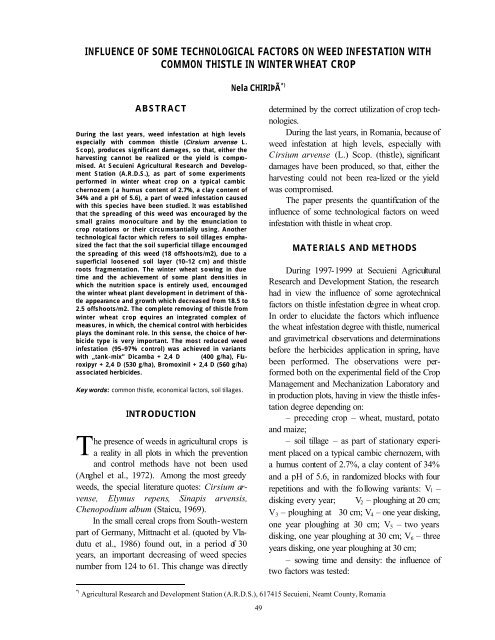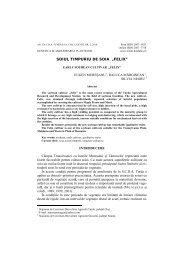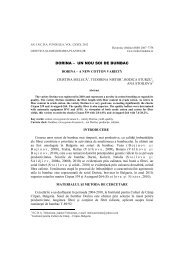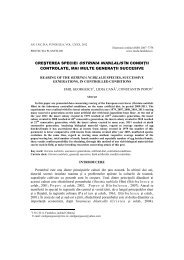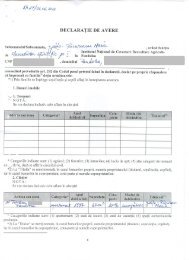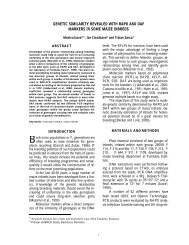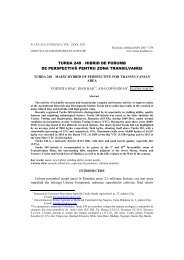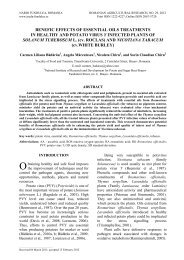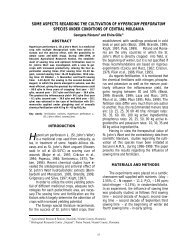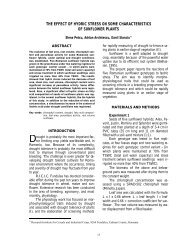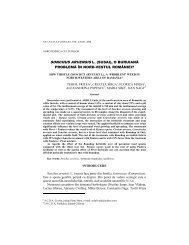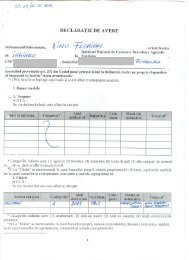influence of some technological factors on weed infestation with ...
influence of some technological factors on weed infestation with ...
influence of some technological factors on weed infestation with ...
You also want an ePaper? Increase the reach of your titles
YUMPU automatically turns print PDFs into web optimized ePapers that Google loves.
INFLUENCE OF SOME TECHNOLOGICAL FACTORS ON WEED INFESTATION WITH<br />
COMMON THISTLE IN WINTER WHEAT CROP<br />
Nela CHIRIÞÃ *)<br />
ABSTRACT<br />
During the last years, <strong>weed</strong> infestati<strong>on</strong> at high levels<br />
especially <strong>with</strong> comm<strong>on</strong> thistle (Cirsium arvense L.<br />
Scop), produces significant damages, so that, either the<br />
harvesting cannot be realized or the yield is compromised.<br />
At Secuieni Agricultural Research and Development<br />
Stati<strong>on</strong> (A.R.D.S.), as part <str<strong>on</strong>g>of</str<strong>on</strong>g> <str<strong>on</strong>g>some</str<strong>on</strong>g> experiments<br />
performed in winter wheat crop <strong>on</strong> a typical cambic<br />
chernozem ( a humus c<strong>on</strong>tent <str<strong>on</strong>g>of</str<strong>on</strong>g> 2.7%, a clay c<strong>on</strong>tent <str<strong>on</strong>g>of</str<strong>on</strong>g><br />
34% and a pH <str<strong>on</strong>g>of</str<strong>on</strong>g> 5.6), a part <str<strong>on</strong>g>of</str<strong>on</strong>g> <strong>weed</strong> infestati<strong>on</strong> caused<br />
<strong>with</strong> this species have been studied. It was established<br />
that the spreading <str<strong>on</strong>g>of</str<strong>on</strong>g> this <strong>weed</strong> was encouraged by the<br />
small grains m<strong>on</strong>oculture and by the renunciati<strong>on</strong> to<br />
crop rotati<strong>on</strong>s or their circumstantially using. Another<br />
<str<strong>on</strong>g>technological</str<strong>on</strong>g> factor which refers to soil tillages emphasized<br />
the fact that the soil superficial tillage encouraged<br />
the spreading <str<strong>on</strong>g>of</str<strong>on</strong>g> this <strong>weed</strong> (18 <str<strong>on</strong>g>of</str<strong>on</strong>g>fshoots/m2), due to a<br />
superficial loosened soil layer (10–12 cm) and thistle<br />
roots fragmentati<strong>on</strong>. The winter wheat sowing in due<br />
time and the achievement <str<strong>on</strong>g>of</str<strong>on</strong>g> <str<strong>on</strong>g>some</str<strong>on</strong>g> plant densities in<br />
which the nutriti<strong>on</strong> space is entirely used, encouraged<br />
the winter wheat plant development in detriment <str<strong>on</strong>g>of</str<strong>on</strong>g> thistle<br />
appearance and growth which decreased from 18.5 to<br />
2.5 <str<strong>on</strong>g>of</str<strong>on</strong>g>fshoots/m2. The complete removing <str<strong>on</strong>g>of</str<strong>on</strong>g> thistle from<br />
winter wheat crop requires an integrated complex <str<strong>on</strong>g>of</str<strong>on</strong>g><br />
measures, in which, the chemical c<strong>on</strong>trol <strong>with</strong> herbicides<br />
plays the dominant role. In this sense, the choice <str<strong>on</strong>g>of</str<strong>on</strong>g> herbicide<br />
type is very important. The most reduced <strong>weed</strong><br />
infestati<strong>on</strong> (95–97% c<strong>on</strong>trol) was achieved in variants<br />
<strong>with</strong> „tank-mix” Dicamba + 2,4 D (400 g/ha), Fluroxipyr<br />
+ 2,4 D (530 g/ha), Bromoxinil + 2,4 D (560 g/ha)<br />
associated herbicides.<br />
Key words: comm<strong>on</strong> thistle, ec<strong>on</strong>omical <str<strong>on</strong>g>factors</str<strong>on</strong>g>, soil tillages.<br />
T<br />
INTRODUCTION<br />
he presence <str<strong>on</strong>g>of</str<strong>on</strong>g> <strong>weed</strong>s in agricultural crops is<br />
a reality in all plots in which the preventi<strong>on</strong><br />
and c<strong>on</strong>trol methods have not been used<br />
(Anghel et al., 1972). Am<strong>on</strong>g the most greedy<br />
<strong>weed</strong>s, the special literature quotes: Cirsium arvense,<br />
Elymus repens, Sinapis arvensis,<br />
Chenopodium album (Staicu, 1969).<br />
In the small cereal crops from South-western<br />
part <str<strong>on</strong>g>of</str<strong>on</strong>g> Germany, Mittnacht et al. (quoted by Vladutu<br />
et al., 1986) found out, in a period <str<strong>on</strong>g>of</str<strong>on</strong>g> 30<br />
years, an important decreasing <str<strong>on</strong>g>of</str<strong>on</strong>g> <strong>weed</strong> species<br />
number from 124 to 61. This change was directly<br />
determined by the correct utilizati<strong>on</strong> <str<strong>on</strong>g>of</str<strong>on</strong>g> crop technologies.<br />
During the last years, in Romania, because <str<strong>on</strong>g>of</str<strong>on</strong>g><br />
<strong>weed</strong> infestati<strong>on</strong> at high levels, especially <strong>with</strong><br />
Cirsium arvense (L.) Scop. (thistle), significant<br />
damages have been produced, so that, either the<br />
harvesting could not been rea-lized or the yield<br />
was compromised.<br />
The paper presents the quantificati<strong>on</strong> <str<strong>on</strong>g>of</str<strong>on</strong>g> the<br />
<str<strong>on</strong>g>influence</str<strong>on</strong>g> <str<strong>on</strong>g>of</str<strong>on</strong>g> <str<strong>on</strong>g>some</str<strong>on</strong>g> <str<strong>on</strong>g>technological</str<strong>on</strong>g> <str<strong>on</strong>g>factors</str<strong>on</strong>g> <strong>on</strong> <strong>weed</strong><br />
infestati<strong>on</strong> <strong>with</strong> thistle in wheat crop.<br />
MATERIALS AND METHODS<br />
During 1997-1999 at Secuieni Agricultural<br />
Research and Development Stati<strong>on</strong>, the research<br />
had in view the <str<strong>on</strong>g>influence</str<strong>on</strong>g> <str<strong>on</strong>g>of</str<strong>on</strong>g> <str<strong>on</strong>g>some</str<strong>on</strong>g> agrotechnical<br />
<str<strong>on</strong>g>factors</str<strong>on</strong>g> <strong>on</strong> thistle infestati<strong>on</strong> degree in wheat crop.<br />
In order to elucidate the <str<strong>on</strong>g>factors</str<strong>on</strong>g> which <str<strong>on</strong>g>influence</str<strong>on</strong>g><br />
the wheat infestati<strong>on</strong> degree <strong>with</strong> thistle, numerical<br />
and gravimetrical observati<strong>on</strong>s and determinati<strong>on</strong>s<br />
before the herbicides applicati<strong>on</strong> in spring, have<br />
been performed. The observati<strong>on</strong>s were performed<br />
both <strong>on</strong> the experimental field <str<strong>on</strong>g>of</str<strong>on</strong>g> the Crop<br />
Management and Mechanizati<strong>on</strong> Laboratory and<br />
in producti<strong>on</strong> plots, having in view the thistle infestati<strong>on</strong><br />
degree depending <strong>on</strong>:<br />
– preceding crop – wheat, mustard, potato<br />
and maize;<br />
– soil tillage – as part <str<strong>on</strong>g>of</str<strong>on</strong>g> stati<strong>on</strong>ary experiment<br />
placed <strong>on</strong> a typical cambic chernozem, <strong>with</strong><br />
a humus c<strong>on</strong>tent <str<strong>on</strong>g>of</str<strong>on</strong>g> 2.7%, a clay c<strong>on</strong>tent <str<strong>on</strong>g>of</str<strong>on</strong>g> 34%<br />
and a pH <str<strong>on</strong>g>of</str<strong>on</strong>g> 5.6, in randomized blocks <strong>with</strong> four<br />
repetiti<strong>on</strong>s and <strong>with</strong> the following variants: V1 –<br />
disking every year; V 2 – ploughing at 20 cm;<br />
V 3 – ploughing at 30 cm; V 4 – <strong>on</strong>e year disking,<br />
<strong>on</strong>e year ploughing at 30 cm; V 5 – two years<br />
disking, <strong>on</strong>e year ploughing at 30 cm; V 6 – three<br />
years disking, <strong>on</strong>e year ploughing at 30 cm;<br />
– sowing time and density: the <str<strong>on</strong>g>influence</str<strong>on</strong>g> <str<strong>on</strong>g>of</str<strong>on</strong>g><br />
two <str<strong>on</strong>g>factors</str<strong>on</strong>g> was tested:<br />
*)<br />
Agricultural Research and Development Stati<strong>on</strong> (A.R.D.S.), 617415 Secuieni, Neamt County, Romania<br />
49
50<br />
ROMANIAN AGRICULTURAL RESEARCH<br />
Number 17 – 18 / 2002<br />
– A factor = sowing time: a1 – 20 th October,<br />
a 2 – 10 th November;<br />
– B factor = sowing density: b 1 – 250 germinable<br />
grains/m 2 , b 2 – 400 germinable grains/m 2 , b 3 – 550 germinable<br />
grains/m 2 ;<br />
– herbicides utilizati<strong>on</strong>: the herbicides were<br />
postemergently applied in the wheat tilling stage<br />
when the thistle had 3–4 leaves.<br />
During the vegetati<strong>on</strong> period, observati<strong>on</strong>s at<br />
15, 30 and 60 days after treatment were performed,<br />
in order to establish the treatment efficiency<br />
by the counting <str<strong>on</strong>g>of</str<strong>on</strong>g> dry <str<strong>on</strong>g>of</str<strong>on</strong>g>fshoots. Before<br />
the wheat harvesting, the gravimetric determinati<strong>on</strong><br />
was d<strong>on</strong>e.<br />
The tested herbicides were:<br />
– 2,4 D 330 g/l (SMDA) ______________________660 g/ha;<br />
– Dicamba 75g/l + 2,4 D 325 g/l (Oltisan extra) ____400 g/ha;<br />
– Fluroxipyr 80 g/l + 2,4 D 450 g/l (Lancet) _______530 g/ha;<br />
– Bromoxinil 280 g/l + 2,4 D 280 g/l (Buctryl U) ___560 g/ha;<br />
– Sulphomethmet<strong>on</strong> 75% (Granstar)_____________ 15 g/ha;<br />
– Amidosulphur<strong>on</strong>e 75% (Grodyl) ______________ 15 g/ha.<br />
The experimental data were processed by<br />
the ANOVA.<br />
RESULTS AND DISCUSSION<br />
The <str<strong>on</strong>g>influence</str<strong>on</strong>g> <str<strong>on</strong>g>of</str<strong>on</strong>g> preceding crop<br />
During 1997–1999, the dynamics <str<strong>on</strong>g>of</str<strong>on</strong>g> wheat<br />
crops <strong>weed</strong> infestati<strong>on</strong> depending <strong>on</strong> different<br />
preceding crops (wheat, mustard, potato and<br />
maize), was tested. Analysing the obtained data,<br />
presented in table 1, it is evident that in the rotati<strong>on</strong><br />
<str<strong>on</strong>g>of</str<strong>on</strong>g> wheat <strong>with</strong> other crops 13 <strong>weed</strong> genera<br />
were determined, Cirsium genus having the biggest<br />
numerical and gravimetrical frequence. Thus,<br />
in wheat cropped after wheat, the biggest <strong>weed</strong><br />
number/m 2 , 171 respectively, from which 22 thistle<br />
<str<strong>on</strong>g>of</str<strong>on</strong>g>fshoots, was registered.<br />
Liubenov, in his research performed in 1982,<br />
indicated that <strong>on</strong>e <str<strong>on</strong>g>of</str<strong>on</strong>g> the main causes <str<strong>on</strong>g>of</str<strong>on</strong>g> thistle infestati<strong>on</strong><br />
in small cereals is the m<strong>on</strong>oculture during<br />
many years. By the wheat cultivati<strong>on</strong> in rotati<strong>on</strong><br />
<strong>with</strong> mustard, potato and maize, a c<strong>on</strong>siderable<br />
decreasing <str<strong>on</strong>g>of</str<strong>on</strong>g> thistle <str<strong>on</strong>g>of</str<strong>on</strong>g>fshoot number/m 2 is<br />
achieved. The most reduced thistle infestati<strong>on</strong> (4<br />
<str<strong>on</strong>g>of</str<strong>on</strong>g>fshoots/m 2 ) was registered by the cultivati<strong>on</strong> <str<strong>on</strong>g>of</str<strong>on</strong>g><br />
wheat in rotati<strong>on</strong> <strong>with</strong> mustard. When the wheat<br />
was sown after potato or maize the thistle <str<strong>on</strong>g>of</str<strong>on</strong>g>fshoot<br />
number/m 2 was <str<strong>on</strong>g>of</str<strong>on</strong>g> ten. In the case <str<strong>on</strong>g>of</str<strong>on</strong>g> wheat sown<br />
in rotati<strong>on</strong> <strong>with</strong> other crops, these changes are due<br />
to the agrotechnical measures applied to the crops<br />
which alternate between them.<br />
The <str<strong>on</strong>g>influence</str<strong>on</strong>g> <str<strong>on</strong>g>of</str<strong>on</strong>g> soil tillages<br />
The research performed by I<strong>on</strong>escu-Sisesti<br />
(1955) and Sin and I<strong>on</strong>ita (1986) showed the role<br />
<str<strong>on</strong>g>of</str<strong>on</strong>g> soil tillages in the <strong>weed</strong> infestati<strong>on</strong> reducti<strong>on</strong>.<br />
On the basis <str<strong>on</strong>g>of</str<strong>on</strong>g> the results obtained at<br />
Secuieni during 1997–1999, the c<strong>on</strong>tributi<strong>on</strong> <str<strong>on</strong>g>of</str<strong>on</strong>g><br />
soil tillage, by the sowing time and ploughing<br />
depth, to the reducti<strong>on</strong> <str<strong>on</strong>g>of</str<strong>on</strong>g> thistle infestati<strong>on</strong> degree<br />
can be pointed out. The determinati<strong>on</strong>s performed<br />
at those three times <str<strong>on</strong>g>of</str<strong>on</strong>g> soil tillages applicati<strong>on</strong><br />
dem<strong>on</strong>strated that the most reduced thistle infestati<strong>on</strong>,<br />
1.6 <str<strong>on</strong>g>of</str<strong>on</strong>g>fshoots/m 2 , was registered when the<br />
ploughing was made after the preceding crop harvesting<br />
and followed by diskings till wheat sowing.<br />
The thistle <str<strong>on</strong>g>of</str<strong>on</strong>g>fshoot number/m 2 increased to nine in<br />
the variant ploughed in summer <strong>with</strong>out disking. In<br />
Table 1. Weed infestati<strong>on</strong> degree in winter wheat after different preceding crops. Secuieni, 1997–1999<br />
Genus and<br />
Number/m 2 Dry matter/m 2<br />
Mean<br />
species Wheat Mustard Potato Maize<br />
Wheat Mustard Potato Maize<br />
Cardaria draba<br />
Cirsium arvense<br />
C<strong>on</strong>volvulus arvensis<br />
Fumaria <str<strong>on</strong>g>of</str<strong>on</strong>g>ficinalis<br />
Galeopsis tetrahit<br />
Galium aparine<br />
Matricaria inodora<br />
Polyg<strong>on</strong>um c<strong>on</strong>volvulus<br />
Sinapis arvensis<br />
S<strong>on</strong>chus arvensis<br />
Stellaria media<br />
Thlaspi arvense<br />
1<br />
22<br />
15<br />
12<br />
17<br />
15<br />
10<br />
29<br />
10<br />
5<br />
20<br />
10<br />
4<br />
4<br />
9<br />
5<br />
4<br />
7<br />
-<br />
8<br />
3<br />
-<br />
7<br />
2<br />
2<br />
10<br />
7<br />
4<br />
2<br />
9<br />
-<br />
5<br />
5<br />
1<br />
10<br />
2<br />
3<br />
10<br />
10<br />
3<br />
7<br />
5<br />
-<br />
7<br />
4<br />
10<br />
11<br />
-<br />
2.5<br />
11.5<br />
10.3<br />
6.0<br />
7.5<br />
9.0<br />
2.5<br />
12.3<br />
5.5<br />
4.0<br />
12.3<br />
3.5<br />
0.9<br />
220.3<br />
11.3<br />
4.9<br />
27.5<br />
20.7<br />
22.7<br />
100.2<br />
17.6<br />
49.7<br />
9.5<br />
3.2<br />
1.6<br />
28.1<br />
7.5<br />
2.8<br />
4.5<br />
9.8<br />
-<br />
7.1<br />
6.1<br />
-<br />
13.9<br />
1.7<br />
1.8<br />
104.1<br />
4.5<br />
1.8<br />
2.5<br />
9.5<br />
-<br />
3.6<br />
7.9<br />
2.5<br />
13.8<br />
1.9<br />
2.0<br />
118.7<br />
6.3<br />
2.6<br />
2.9<br />
2.9<br />
-<br />
6.9<br />
3.5<br />
18.2<br />
19.1<br />
-<br />
Mean<br />
1.6<br />
117.8<br />
7.4<br />
3.0<br />
9.4<br />
14.1<br />
5.2<br />
10.1<br />
29.4<br />
9.6<br />
24.1<br />
3.3
NELA CHIRIÞÃ: INFLUENCE OF SOME TECHNOLOGICAL FACTORS ON WEED INFESTATION WITH COMMON<br />
THISTLE IN WINTER WHEAT CROP<br />
51<br />
the variant ploughed in autumn before sowing, the<br />
infestati<strong>on</strong> degree registered the highest value, <str<strong>on</strong>g>of</str<strong>on</strong>g><br />
10.7 <str<strong>on</strong>g>of</str<strong>on</strong>g>fshoots/m 2 (Figure 1).<br />
As regards the soil tillage depth, the data obtained<br />
showed that the ploughing depth difference<br />
from 20 cm and 30 cm c<strong>on</strong>tributed to the diminuti<strong>on</strong><br />
<str<strong>on</strong>g>of</str<strong>on</strong>g> <strong>weed</strong> total number and <str<strong>on</strong>g>of</str<strong>on</strong>g> thistle infestati<strong>on</strong>.<br />
<str<strong>on</strong>g>of</str<strong>on</strong>g>f-<br />
Figure 1. Influence <str<strong>on</strong>g>of</str<strong>on</strong>g> soil tillage time <strong>on</strong> thistle<br />
shoot number<br />
Thus, in the variant in which the ploughing<br />
was made at 20 cm depth, the thistle infestati<strong>on</strong><br />
was <str<strong>on</strong>g>of</str<strong>on</strong>g> 4 <str<strong>on</strong>g>of</str<strong>on</strong>g>fshoots/m 2 , while in the variant<br />
ploughed at 30 cm, was <str<strong>on</strong>g>of</str<strong>on</strong>g> 2 <str<strong>on</strong>g>of</str<strong>on</strong>g>fshoots/m 2 . Soil<br />
superficial tillage, year by year and following the<br />
thistle roots fragmentati<strong>on</strong>, encourages the thistle<br />
infestati<strong>on</strong>, in a number <str<strong>on</strong>g>of</str<strong>on</strong>g> 18 <str<strong>on</strong>g>of</str<strong>on</strong>g>fshoot/m 2 in the<br />
variant disked every year, and <str<strong>on</strong>g>of</str<strong>on</strong>g> 11 <str<strong>on</strong>g>of</str<strong>on</strong>g>fshoots/m 2<br />
in the variant disked three years followed by<br />
ploughing at 30 cm (Table 2).<br />
Influence <str<strong>on</strong>g>of</str<strong>on</strong>g> sowing time and density<br />
From the average observati<strong>on</strong>s presented in<br />
table 3, it is evident that the sowing technology by<br />
crop density and sowing time had decisive effects<br />
<strong>on</strong> <strong>weed</strong> infestati<strong>on</strong> degree.<br />
Thus, in the case <str<strong>on</strong>g>of</str<strong>on</strong>g> late sowing time (10 th<br />
November), the total wheat <strong>weed</strong> infestati<strong>on</strong> increased<br />
from 108 to 129 <strong>weed</strong>s/m 2 and the thistle<br />
<str<strong>on</strong>g>of</str<strong>on</strong>g>fshoot number increased by 2.2 times.<br />
This thing can be explained by the weak<br />
covering <str<strong>on</strong>g>of</str<strong>on</strong>g> field <strong>with</strong> wheat plants because <str<strong>on</strong>g>of</str<strong>on</strong>g><br />
small spike number/surface unit. As follows <str<strong>on</strong>g>of</str<strong>on</strong>g> low<br />
competiti<strong>on</strong> <str<strong>on</strong>g>of</str<strong>on</strong>g> wheat plants and reduced growing<br />
vigour, the thistle had a high sprouting degree because<br />
<str<strong>on</strong>g>of</str<strong>on</strong>g> improved light, water and mineral nutriti<strong>on</strong><br />
c<strong>on</strong>diti<strong>on</strong>s (Table 4).<br />
The sowing in due time, in Moldavia<br />
(1 st -20 th October), ensured a wheat density at<br />
which the nutriti<strong>on</strong> and light space was entirely<br />
utilized by wheat plants, c<strong>on</strong>tributing to the <strong>weed</strong><br />
infestati<strong>on</strong> diminuti<strong>on</strong>.<br />
It is also evident an obvious decreasing <str<strong>on</strong>g>of</str<strong>on</strong>g><br />
thistle <str<strong>on</strong>g>of</str<strong>on</strong>g>fshoot number from 18.5 to 2.5/m 2 , in the<br />
sowing variants <strong>with</strong> 550 germinable grains/m 2 .<br />
C<strong>on</strong>comitantly <strong>with</strong> the increasing <str<strong>on</strong>g>of</str<strong>on</strong>g> sowing<br />
density, the field covering degree increased, too.<br />
As follows, the growth c<strong>on</strong>diti<strong>on</strong>s <str<strong>on</strong>g>of</str<strong>on</strong>g> thistle and <str<strong>on</strong>g>of</str<strong>on</strong>g><br />
Table 2. Influence <str<strong>on</strong>g>of</str<strong>on</strong>g> soil tillage system <strong>on</strong> wheat infestati<strong>on</strong> (determinati<strong>on</strong>s in spring, stati<strong>on</strong>ary experiment)<br />
Variants<br />
1. Disking every year<br />
2. Ploughing at 20 cm<br />
3. Ploughing at 30 cm<br />
4. One year disking, <strong>on</strong>e year<br />
ploughing at 30 cm<br />
5. Two years disking, <strong>on</strong>e<br />
year ploughing at 30 cm<br />
6. There years disking, <strong>on</strong>e year<br />
ploughing at 30 cm<br />
Total<br />
<strong>weed</strong><br />
no/m 2<br />
420<br />
125<br />
110<br />
206<br />
224<br />
317<br />
1997 1998 1999<br />
Cirsium<br />
no/m 2<br />
18<br />
6<br />
1<br />
5<br />
8<br />
Total<br />
<strong>weed</strong>s<br />
no/m 2<br />
399<br />
144<br />
165<br />
227<br />
293<br />
Cirsium<br />
no/m 2<br />
16<br />
2<br />
3<br />
7<br />
6<br />
Total<br />
<strong>weed</strong>s<br />
no/m 2<br />
375<br />
170<br />
158<br />
199<br />
287<br />
other <strong>weed</strong>s worsened.<br />
Cirsium<br />
no/m 2<br />
Average<br />
(1997–1999)<br />
Total<br />
<strong>weed</strong><br />
no/m 2<br />
398<br />
146<br />
144<br />
Cirsium<br />
no/m 2<br />
11 375 10 333 14 342 11.7<br />
LSD 5% 4.9 2.7<br />
21<br />
4<br />
2<br />
4<br />
6<br />
211<br />
268<br />
18.3<br />
4.0<br />
2.0<br />
5.3<br />
7.3
52<br />
ROMANIAN AGRICULTURAL RESEARCH<br />
Number 17 – 18 / 2002<br />
Table 3. Influence <str<strong>on</strong>g>of</str<strong>on</strong>g> sowing time and density <strong>on</strong> <strong>weed</strong> infestati<strong>on</strong> degree in wheat crop (1997–1999)<br />
Time (A) First time Sec<strong>on</strong>d time<br />
Density<br />
(germinable<br />
Weeds/m 2 Weeds/m 2<br />
B average<br />
grains/m 2<br />
Cirsium<br />
sium<br />
sium<br />
Cir -<br />
Cir-<br />
total diff. sign. diff. sign. total diff. sign. diff. sign.<br />
(B)<br />
diff. sign.<br />
250 186 c<strong>on</strong>trol – 13 c<strong>on</strong>trol – 220 c<strong>on</strong>trol – 24 c<strong>on</strong>trol – 18,5 c<strong>on</strong>trol –<br />
400 95 –91 ooo 3 –10 °°° 110 –110 °°° 6 –18 °°° 4,5 –14 °°°<br />
550 44 –142 1 –12 °°° 58 –162 °°° 4 –20 °°° 2,5 –16 °°°<br />
A average 108 5 129 11<br />
Dif. c<strong>on</strong>trol c<strong>on</strong>trol 21 6<br />
Signif. – – ** ***<br />
LSD 5%: (A) 4.1 1.9<br />
(B) 10.8 3.6<br />
(A x B) 13.0 5.1<br />
(B x A) 15.3 5.9<br />
Table 4 . Influence <str<strong>on</strong>g>of</str<strong>on</strong>g> sowing time and density <strong>on</strong> wheat infestati<strong>on</strong> degree (1997-1999)<br />
A factor<br />
(Sowing time)<br />
B factor<br />
(Densities)<br />
Weed infestati<strong>on</strong> degree at<br />
the <str<strong>on</strong>g>factors</str<strong>on</strong>g> interacti<strong>on</strong><br />
Average number<br />
<str<strong>on</strong>g>of</str<strong>on</strong>g> spikes/m 2<br />
A 1<br />
. 20 th October<br />
A 2 . 10 th November<br />
Influence <str<strong>on</strong>g>of</str<strong>on</strong>g> herbicides<br />
b 1<br />
- 250<br />
b 2<br />
- 400<br />
b 3<br />
- 550<br />
b 1 - 250<br />
b 2 - 400<br />
b 3 - 550<br />
The results obtained during 1997–1999, presented<br />
in table 5, emphasize a diminuti<strong>on</strong> <str<strong>on</strong>g>of</str<strong>on</strong>g> thistle<br />
infestati<strong>on</strong> till 97%, in treated variants as compared<br />
<strong>with</strong> the untreated c<strong>on</strong>trol.<br />
During the three years <str<strong>on</strong>g>of</str<strong>on</strong>g> experimentati<strong>on</strong>,<br />
the best results <str<strong>on</strong>g>of</str<strong>on</strong>g> c<strong>on</strong>trol (95–97%) were obtained<br />
in variants in which the „tank-mix” Dicamba<br />
+ 2,4 D – 400 g/ha; Fluroxipyr + 2,4 D - 530<br />
g/ha; Bromoxinil + 2,4 D – 560 g/ha associated<br />
186 (13 Cirsium)<br />
95(3)<br />
44(1)<br />
220(24)<br />
110(10)<br />
58(4)<br />
490<br />
510<br />
564<br />
279<br />
392<br />
505<br />
herbicides, were used.<br />
In the variants in which the herbicides bel<strong>on</strong>ging<br />
to sulphorilureic (sulphometh<strong>on</strong>) group<br />
were <strong>on</strong>ly applied, the c<strong>on</strong>trol percentage was<br />
lower (73%) and in variants in which <strong>on</strong>ly amidosulphur<strong>on</strong>e<br />
was applied (15 g/ha), the efficiency in<br />
thistle c<strong>on</strong>trol was absent. These results emphasize<br />
the importance <str<strong>on</strong>g>of</str<strong>on</strong>g> herbicides choosing as part<br />
<str<strong>on</strong>g>of</str<strong>on</strong>g> c<strong>on</strong>trol strategies elaborati<strong>on</strong> for certain <strong>weed</strong><br />
species.<br />
Table 5 . Efficiency <str<strong>on</strong>g>of</str<strong>on</strong>g> herbicides in thistle c<strong>on</strong>trol from wheat crop (1997–1999)<br />
Herbicides<br />
Untreated<br />
2,4 D<br />
Dicamba/2.4D<br />
Fluroxipyr/2.4D<br />
Bromoxinil/2.4D<br />
Sulphomethmet<strong>on</strong><br />
Amidosulphur<strong>on</strong>e<br />
LSD:<br />
Dose<br />
(g active ingredient/ha)<br />
-<br />
660<br />
400<br />
530<br />
560<br />
15<br />
15<br />
5% = 790 kg/ha<br />
1% = 1084 kg/ha<br />
0.1% = 1476 kg/ha<br />
Aerial<br />
mass<br />
848<br />
88<br />
12<br />
16<br />
22<br />
340<br />
735<br />
Thistle, kg active<br />
ingredient/ha<br />
Underground<br />
mass<br />
1286<br />
202<br />
77<br />
65<br />
79<br />
795<br />
1270<br />
Total<br />
2134<br />
290<br />
89<br />
81<br />
101<br />
1135<br />
2005<br />
C<strong>on</strong>trol<br />
(%)<br />
-<br />
87<br />
96<br />
97<br />
95<br />
47<br />
6<br />
Wheat yield<br />
kg/ha %<br />
1910<br />
5075<br />
5300<br />
5380<br />
5270<br />
3450<br />
2110<br />
100<br />
265<br />
277<br />
282<br />
276<br />
181<br />
110
NELA CHIRIÞÃ: INFLUENCE OF SOME TECHNOLOGICAL FACTORS ON WEED INFESTATION WITH COMMON<br />
THISTLE IN WINTER WHEAT CROP<br />
53<br />
CONCLUSIONS<br />
The main factor which c<strong>on</strong>tributed to the<br />
thistle infestati<strong>on</strong> <str<strong>on</strong>g>of</str<strong>on</strong>g> small grains was rotati<strong>on</strong> <str<strong>on</strong>g>of</str<strong>on</strong>g><br />
cereals and especially m<strong>on</strong>oculture. The introducti<strong>on</strong>,<br />
as part <str<strong>on</strong>g>of</str<strong>on</strong>g> rotati<strong>on</strong>, <str<strong>on</strong>g>of</str<strong>on</strong>g> <str<strong>on</strong>g>some</str<strong>on</strong>g> crops which<br />
compete thistle as regards the grown c<strong>on</strong>diti<strong>on</strong>s<br />
(mustard) as well as <str<strong>on</strong>g>of</str<strong>on</strong>g> <str<strong>on</strong>g>some</str<strong>on</strong>g> row-crops (potato,<br />
maize) c<strong>on</strong>tributed to the diminuti<strong>on</strong> <str<strong>on</strong>g>of</str<strong>on</strong>g> thistle infestati<strong>on</strong><br />
degree from 22 to 4, respectively 10 <str<strong>on</strong>g>of</str<strong>on</strong>g>fshoots/m<br />
2 .<br />
The soil tillages <str<strong>on</strong>g>influence</str<strong>on</strong>g>d the thistle infestati<strong>on</strong><br />
degree, in the sense that the most reduced<br />
infestati<strong>on</strong> (2 <str<strong>on</strong>g>of</str<strong>on</strong>g>fshoots/m 2 ) was registered in the<br />
variants ploughed in summer at 20 cm followed by<br />
three diskings. The soil superficial tillage encouraged<br />
the spreading <str<strong>on</strong>g>of</str<strong>on</strong>g> this <strong>weed</strong> (18 <str<strong>on</strong>g>of</str<strong>on</strong>g>fshoots/m<br />
2 ), because <str<strong>on</strong>g>of</str<strong>on</strong>g> a superficial loosened soil<br />
layer (10–12 cm) and <str<strong>on</strong>g>of</str<strong>on</strong>g> the thistle roots fragmentati<strong>on</strong><br />
(10–12 cm layer).<br />
The wheat sowing in due time and the<br />
achievement <str<strong>on</strong>g>of</str<strong>on</strong>g> <str<strong>on</strong>g>some</str<strong>on</strong>g> plant densities <strong>with</strong> the nutriti<strong>on</strong><br />
space entirely utilized, encourage the wheat<br />
plants development in detriment <str<strong>on</strong>g>of</str<strong>on</strong>g> thistle appearance<br />
and growth. In this case, the thistle<br />
number decreased from 18.5 to 2.5 <str<strong>on</strong>g>of</str<strong>on</strong>g>fshoots/m 2 .<br />
The most reduced thistle infestati<strong>on</strong> (95–<br />
97%) was achieved in the variants in which the<br />
„tank-mix”, Dicamba + 2,4 D (400g/ha); Fluroxipyr<br />
+ 2,4 D (530 g/ha); Bromoxinil + 2,4 D<br />
(560 g/ha) associated herbicides, were used.<br />
REFERENCES<br />
Anghel, Gh., Chirilã, C., Ciocârlan, V., Ulinici, A., 1972. Buruienile<br />
din culturile agricole ºi combaterea lor. Edit. Ceres<br />
, Bucureºti: 1–80.<br />
I<strong>on</strong>escu ªiºeºti, Gh., 1955. Buruienile ºi combaterea lor. Edit.<br />
Agro-Silvicã de Stat, Bucureºti: 74–77.<br />
Liubenov, I.G., 1982. Problema buruienilor perene cu rizomi ºi<br />
cu lãstãrire din rãdãcini, în Bulgaria ºi cãile de rezolvare a<br />
ei. Combaterea chimicã a buruienilor perene din culturile<br />
de câmp, viþã de vie ºi pajiºti. Bucureºti: 17–23.<br />
Sin, Gh., I<strong>on</strong>iþã, St., 1986. Influenþa unor factori agrotehnici<br />
asupra îmburuienãrii culturilor de grâu ºi porumb.<br />
Folosirea raþi<strong>on</strong>alã a erbicidelor, C<strong>on</strong>stanþa: 23-30.<br />
Staicu, I., 1969. Agrotehnica. Edit. Agro-Silvicã, Bucureºti:<br />
368–376.<br />
Vlãduþu, I., Fritea, T., ªarpe, N., 1986. Efectul aplicãrii erbicidelor<br />
în cadrul unui asolament specific podzolului argiloiluvial<br />
din nord-vestul þãrii. Folosirea raþi<strong>on</strong>alã a erbicidelor,<br />
C<strong>on</strong>stanþa: 46–59.
54<br />
ROMANIAN AGRICULTURAL RESEARCH<br />
Number 17 – 18 / 2002<br />
Table 1. Reproducti<strong>on</strong> ability <str<strong>on</strong>g>of</str<strong>on</strong>g> the E. integriceps recent generati<strong>on</strong>s,<br />
as compared <strong>with</strong> multiannual average (1970-2000) and <strong>with</strong> the<br />
specific years: favourable (1986) and unfavourable (1989).<br />
Natural<br />
gene<br />
rati<strong>on</strong> <str<strong>on</strong>g>of</str<strong>on</strong>g> E.<br />
Prolificacy (egg/female)<br />
under<br />
field<br />
c<strong>on</strong>di<br />
ti<strong>on</strong>s<br />
under c<strong>on</strong>trolled<br />
c<strong>on</strong>diti<strong>on</strong>s<br />
1970-2000<br />
1986<br />
1989<br />
1996<br />
1997<br />
1998<br />
1999<br />
2000<br />
40.2<br />
56.3<br />
18.8<br />
47.1<br />
46.6<br />
37.5<br />
38.8<br />
39.3<br />
57.9<br />
71.3<br />
27.1<br />
69.9<br />
68.6<br />
53.8<br />
54.5<br />
55.7<br />
311<br />
298<br />
87<br />
302<br />
197<br />
209<br />
219<br />
208<br />
23.4<br />
22.5<br />
26.5<br />
27.9<br />
28.0<br />
29.7<br />
29.8<br />
1989-1990<br />
1972-1973<br />
1971-1972<br />
1977-1978<br />
1984-1985<br />
1985-1986<br />
1994-1995<br />
integriceps average maximum/fe<br />
male<br />
Table 2. Prolificacy level <str<strong>on</strong>g>of</str<strong>on</strong>g> <str<strong>on</strong>g>some</str<strong>on</strong>g> E. integriceps populati<strong>on</strong>s (fertile<br />
females), from generati<strong>on</strong>s <strong>with</strong> different fat body levels, collected from<br />
the field, at the beginning <str<strong>on</strong>g>of</str<strong>on</strong>g> migrati<strong>on</strong> and studied under c<strong>on</strong>trolled<br />
c<strong>on</strong>diti<strong>on</strong>s.<br />
Fat<br />
body<br />
Generati<strong>on</strong> Prolificacy<br />
(egg/female)<br />
aver-<br />
maxi-<br />
age<br />
32.1<br />
33.4<br />
46.4<br />
67.5<br />
83.6<br />
95.3<br />
104.7<br />
mum<br />
97<br />
127<br />
148<br />
186<br />
210<br />
234<br />
246<br />
Table 3. Level and stages <str<strong>on</strong>g>of</str<strong>on</strong>g> fat body diminuti<strong>on</strong> at E. integriceps<br />
(multigenerati<strong>on</strong> average).<br />
Stages Fat body level Diminuti<strong>on</strong><br />
Diapause<br />
beginning<br />
limits average limits average<br />
33.03-37.58 35.69 0 0
NELA CHIRIÞÃ: INFLUENCE OF SOME TECHNOLOGICAL FACTORS ON WEED INFESTATION WITH COMMON<br />
THISTLE IN WINTER WHEAT CROP<br />
55<br />
End <str<strong>on</strong>g>of</str<strong>on</strong>g> diapause<br />
End <str<strong>on</strong>g>of</str<strong>on</strong>g> ovipositi<strong>on</strong><br />
21.97-27.64 25.43 24.57-<br />
36.33<br />
8.12-10.39 8.78 66.50-<br />
78.69<br />
27.39<br />
74.43<br />
Table 4. Mortality registered at the Eurygaster integriceps<br />
populati<strong>on</strong>s, during diapause in different generati<strong>on</strong>s, from<br />
Romanian area<br />
E. integriceps Mortality (%)<br />
natural populati<strong>on</strong><br />
Limits in coun-<br />
Total area<br />
2000-2001<br />
1995-1996<br />
2001-2002<br />
1985-1988<br />
1999-2000<br />
1973-1974<br />
1988-1989<br />
(mean)<br />
8.7<br />
10.2<br />
12.7<br />
14.8<br />
24.5<br />
39.5<br />
48.2<br />
Table 5. Fat body value at Eurygaster integriceps populati<strong>on</strong>s,<br />
established <strong>on</strong> female groups, distributed in weight classes, at the<br />
beginning <str<strong>on</strong>g>of</str<strong>on</strong>g> diapause (multigenerati<strong>on</strong> average).<br />
Weight (mg)<br />
below 0.110<br />
0.111-0.118<br />
0.119-0.126<br />
0.127-0.134<br />
over 0.145<br />
% from the total <str<strong>on</strong>g>of</str<strong>on</strong>g> Fat body (%)<br />
populati<strong>on</strong><br />
limits average limits average<br />
3.7-7.7 5.6 26.2-26.6 26.4<br />
7.6-23.1 13.3 26.5-28.8 28.7<br />
15.9-24.7 19.7 32.8-33.5 33.6<br />
32.5-34.8 33.7 34.9-36.4 35.4<br />
22.4-30.8 28.6 35.7-39.8 38.7<br />
Table 6. Fat body value at Eurygaster integriceps populati<strong>on</strong>s,<br />
established <strong>on</strong> male groups, distributed in weight classes, at the<br />
beginning <str<strong>on</strong>g>of</str<strong>on</strong>g> diapause (multigenerati<strong>on</strong> average).<br />
Weight (mg)<br />
below 0.105<br />
0.106-0.113<br />
0.114-0.121<br />
0.122-0.129<br />
over 0.130<br />
Fat body (%)<br />
limits<br />
25.3-26.7<br />
27.2-28.5<br />
29.4-33.8<br />
31.2-35.5<br />
31.4-36.6<br />
ties<br />
4.6-35.7<br />
3.7-36.4<br />
5.1-32.3<br />
3.8-41.2<br />
4.8-97.6<br />
11.6-85.0<br />
17.5-68.4<br />
% from the total <str<strong>on</strong>g>of</str<strong>on</strong>g><br />
populati<strong>on</strong><br />
limits average<br />
7.0-19.7 12.3<br />
16.8-19.9 17.3<br />
20.3-29.5 23.7<br />
19.2-32.7 28.5<br />
15.5-23.9 19.4<br />
average<br />
26.2<br />
27.7<br />
31.5<br />
32.6<br />
33.8
56<br />
ROMANIAN AGRICULTURAL RESEARCH<br />
Number 17 – 18 / 2002<br />
Table 7. Mortality (%) registered at Eurygaster integriceps female<br />
populati<strong>on</strong>s, depending <strong>on</strong> the fat body (multigenerati<strong>on</strong> average).<br />
Fat<br />
body<br />
(%)<br />
26.4<br />
28.7<br />
33.6<br />
35.4<br />
38.7<br />
Mortality (%)<br />
During August-<br />
October<br />
During November-<br />
March<br />
limits average limits average<br />
17-22 20.4 59-64 61.3<br />
13-15 12.9 43-54 47.6<br />
9-17 12.5 41-52 46.2<br />
4-11 6.6 29-34 33.6<br />
4-7 5.8 26-35 30.9<br />
Table 8. Mortality (%) registered at Eurygaster integriceps male<br />
populati<strong>on</strong>s, depending <strong>on</strong> the fat body (multigenerati<strong>on</strong> average).<br />
Fat<br />
body<br />
(%)<br />
26.2<br />
27.7<br />
31.5<br />
32.6<br />
33.8<br />
Mortality (%)<br />
During August- During November-<br />
October<br />
March<br />
limits average limits average<br />
22-31 22.6 62-71 67.1<br />
11-24 20.4 53-62 57.4<br />
12-19 14.3 39-47 44.0<br />
9-18 12.7 30-44 37.6<br />
5-14 9.1 24-45 32.3<br />
Table 9. Sterility and prolificacy registered at the Eurygaster<br />
integriceps populati<strong>on</strong>s, depending <strong>on</strong> the fat body (multigenerati<strong>on</strong><br />
average).<br />
Mean prolificacy (egg/female)<br />
limits<br />
0<br />
4.1-6.6<br />
16.2-22.8<br />
26.4-33.1<br />
38.9-51.7<br />
Fat<br />
body<br />
Females sterility<br />
(%)<br />
(%) limits average<br />
26.4 100 100<br />
28.7 60-72 63.5<br />
33.6 54-63 57.3<br />
35.4 35-44 39.1<br />
38.7 25-32 29.8<br />
average<br />
0<br />
5.4<br />
19.5<br />
30.3<br />
45.8<br />
maximum<br />
0<br />
42<br />
78<br />
135<br />
194<br />
Table 10. Multiplicati<strong>on</strong> index at the Eurygaster integriceps<br />
populati<strong>on</strong>s, depending <strong>on</strong> the fat body (multigenerati<strong>on</strong> average).<br />
Fat Multiplicati<strong>on</strong> index<br />
body<br />
(%)<br />
(egg/female)<br />
limits average<br />
26.4<br />
28.7<br />
33.6<br />
35.4<br />
38.7<br />
0<br />
0.37–2.47<br />
4.54–9.62<br />
28.57–40.18<br />
49.38–64.83<br />
0<br />
1.54<br />
6.95<br />
35.22<br />
56.47


